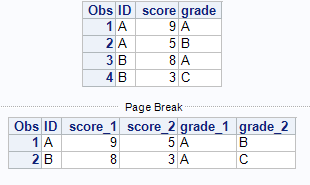- Home
- /
- Programming
- /
- SAS Procedures
- /
- Re: Transpose two variables at the same time
- RSS Feed
- Mark Topic as New
- Mark Topic as Read
- Float this Topic for Current User
- Bookmark
- Subscribe
- Mute
- Printer Friendly Page
- Mark as New
- Bookmark
- Subscribe
- Mute
- RSS Feed
- Permalink
- Report Inappropriate Content
Hello,
The data I have is as follows:
| ID | Score | Grade |
| A | 9 | A |
| A | 5 | B |
| B | 8 | A |
| B | 3 | C |
I want to transpose it as follows:
| ID | Score1 | Score2 | Grade1 | Grade2 |
| A | 9 | 5 | A | B |
| B | 8 | 3 | A | C |
However, I'm not able to transpose two variables at the same time -- prefix doesn't take two variables. I'm transposing one variable at a time and then merging the two datasets. Could this be done in one step?
Thanks,
P
Accepted Solutions
- Mark as New
- Bookmark
- Subscribe
- Mute
- RSS Feed
- Permalink
- Report Inappropriate Content
To calculate max obs per ID you can do this. This works with max obs per ID of 100 or less. One nice feature of this "transpose" in addition of multiple variables is the data types are preserved.
select max(obs) into :obs from(select count(*) as obs from tests group by ID);
quit;
proc summary data=tests nway;
class ID;
output out=wide(drop=_:) idgroup(out[&obs](score grade)=);
run;
- Mark as New
- Bookmark
- Subscribe
- Mute
- RSS Feed
- Permalink
- Report Inappropriate Content
Are there always exactly 2 values for ID? If so:
Data want (drop= score grade);
set have;
length grade1 grade2 $ 1;
retain score1 grade1;
by id notsorted;
if first.id then do;
score1=score;
grade1=grade;
end;
if last.id then do;
score2=score;
grade2=grade;
output;
end;
run;
might work
- Mark as New
- Bookmark
- Subscribe
- Mute
- RSS Feed
- Permalink
- Report Inappropriate Content
Hi - just wanted you to know that I moved this message from the 'about communities" community into the SAS Procedures community. Thanks!
- Mark as New
- Bookmark
- Subscribe
- Mute
- RSS Feed
- Permalink
- Report Inappropriate Content
Thanks, but there are varying number of records for each ID.
- Mark as New
- Bookmark
- Subscribe
- Mute
- RSS Feed
- Permalink
- Report Inappropriate Content
You would need to decide what the driving maximum is then. In the code below I assume max count of grades with be the maximum number of columns. Also note, that I put extra code in the final step, whilst in your example it works fine I add this code to cover times where one or the other is missing (as it would retain previous in that instance:
data have;
infile datalines;
input ID $ Score Grade $;
datalines;
A 9 A
A 5 B
B 8 A
B 3 C
;
run;
proc sql noprint;
select max(CNT)
into :TOT_ARRAY
from (select ID,COUNT(GRADE) as CNT from WORK.HAVE group by ID)
group by ID;
quit;
data want (drop=array_cnt i score grade);
set have;
array score_{&TOT_ARRAY.} 8.;
array grade_{&TOT_ARRAY.} $1.;
by id;
retain array_cnt score_1-score_%trim(&TOT_ARRAY.) grade_1-grade_%trim(&TOT_ARRAY.);
if first.id then array_cnt=1;
score_{array_cnt}=score;
grade_{array_cnt}=grade;
array_cnt=array_cnt+1;
if last.id then do;
output;
do i=1 to &TOT_ARRAY.;
score_{i}=.;
grade_{i}="";
end;
end;
run;
- Mark as New
- Bookmark
- Subscribe
- Mute
- RSS Feed
- Permalink
- Report Inappropriate Content
Thanks both, RW9 and data_null_ !
- Mark as New
- Bookmark
- Subscribe
- Mute
- RSS Feed
- Permalink
- Report Inappropriate Content
You can use PROC SUMMARY. You do have to know or calculate the max obs by ID 2 in your.
data tests;
infile cards expandtabs;
input ID :$1. score grade :$1.;
cards;
A 9 A
A 5 B
B 8 A
B 3 C
;;;;
run;
proc print;
run;
proc summary data=tests nway;
class ID;
output out=wide(drop=_:) idgroup(out[2](score grade)=);
run;
proc print;
run;
- Mark as New
- Bookmark
- Subscribe
- Mute
- RSS Feed
- Permalink
- Report Inappropriate Content
To calculate max obs per ID you can do this. This works with max obs per ID of 100 or less. One nice feature of this "transpose" in addition of multiple variables is the data types are preserved.
select max(obs) into :obs from(select count(*) as obs from tests group by ID);
quit;
proc summary data=tests nway;
class ID;
output out=wide(drop=_:) idgroup(out[&obs](score grade)=);
run;
April 27 – 30 | Gaylord Texan | Grapevine, Texas
Registration is open
Walk in ready to learn. Walk out ready to deliver. This is the data and AI conference you can't afford to miss.
Register now and lock in 2025 pricing—just $495!
Learn the difference between classical and Bayesian statistical approaches and see a few PROC examples to perform Bayesian analysis in this video.
Find more tutorials on the SAS Users YouTube channel.
SAS Training: Just a Click Away
Ready to level-up your skills? Choose your own adventure.



